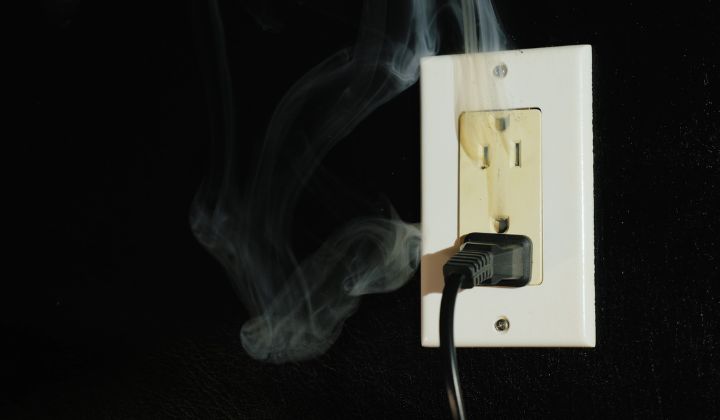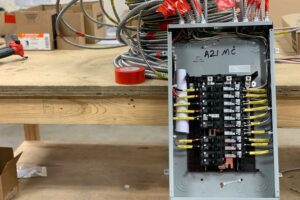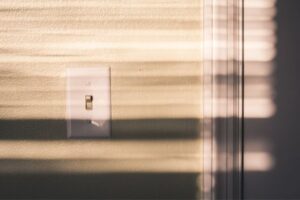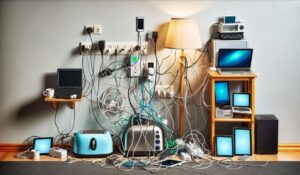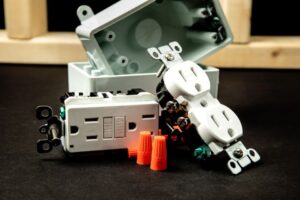Electricity plays a fundamental role in powering our homes, businesses, and devices. However, electrical issues can cause serious problems if left unattended. If your outlet is smoking, this can be a sign of a few issues. Regardless, we advise you to take it seriously and take action immediately.
If you’ve got smoke coming from an outlet, unplug all devices from the outlet and turn off the breaker box. A smoking outlet can result from various issues, including overloaded circuits, faulty wiring, short circuits, malfunctioning appliances, or even the precursor to an electrical fire.
In this article, we’ll discuss what to do if you have a smoking outlet, the five potential causes a smoking outlet, and discuss what to do about each of them.
What to do if you’ve got a smoking electrical outlet
Discovering an electrical outlet smoking can be alarming, but taking the right steps promptly can mitigate potential hazards. Here’s a step-by-step guide on what to do if you encounter a smoking outlet:
- Prioritize safety by ensuring everyone leaves the immediate area
- Power off and disconnect devices from the smoking outlet
- Turn off the power to the affected area by turning off the circuit breaker
- Do not use water! Never attempt to extinguish an electrical fire with water, as water conducts electricity and can lead to further complications. Instead, use a fire extinguisher designed for electrical fires. Remember that small fires can quickly become larger fires.
- If the situation escalates to sparks, flames, or excessive heat, call emergency services immediately and evacuate the premises.
- Refrain from touching the smoking outlet or any surrounding wires. The risk of electric shock is high, and it’s crucial to leave electrical troubleshooting to professionals.
- If the smoking is minor and there is no immediate danger, ventilate the area by opening windows and doors to allow the smoke to disperse.
- Once the situation is under control, consult with a qualified electrician to inspect and address the cause of the smoking outlet. Do not use the outlet until it has been deemed safe by a professional.
Ensure that everyone in your household is aware of basic electrical safety practices. This includes recognizing the signs of electrical issues and knowing how to respond in case of an emergency.
By following these steps and prioritizing safety, you can effectively address a smoking outlet and reduce the risk of electrical hazards in your home. Remember, when in doubt, seek professional assistance to ensure a thorough and safe resolution.
Top 5 causes of smoking outlets
The most common causes of smoke coming out of an outlet are:
- Overloaded circuits
- Faulty wiring
- Short circuits
- Malfunctioning appliances
- A precursor to an electrical fire
1. Overloaded Circuits
One frequent reason for a smoking outlet is an overloaded circuit. Connecting too many appliances or devices to a single outlet or circuit can lead to overheating and, in severe cases, smoking. This situation can pose dangers that need prompt attention.
Solution: To prevent overloaded outlets, disperse your electrical devices across different outlets and circuits. Consider using power strips with surge protection to avoid excessive current flow. If you’re unsure of how many devices may be too many, consider having an electrician come to your home or business to assess the situation.
2. Faulty Wiring
If your outlet is smoking with nothing plugged in, it could be faulty wiring, loose wiring, faulty grounds, or ungrounded outlets. Over time, wiring can wear out, become frayed, or your electrical system can suffer damage due to pests or environmental factors. This is especially true when dealing with old breaker boxes or wiring. When the protective sheathing around the wires is compromised, it can lead to damaged connections, overheating, and potentially cause a fire.
Solution: Inspect your property’s wiring for any signs of damage. You can also have a licensed electrician audit the wiring in your home or business if you would like a professional opinion. If you notice exposed wires or suspect an issue, consult with a qualified electrician to assess and repair the wiring.
3. Short Circuits
Short circuits occur when two wires with different charges come into contact, creating a direct path for electricity. This sudden surge of current can generate heat, leading to a smoking outlet or an outlet that doesn’t work.
Solution: To prevent short circuits, avoid using damaged or frayed cords and cables. If you discover a short circuit, turn off the power to that outlet immediately and seek professional help to address the issue.
4. Malfunctioning Appliances
If your outlet is smoking when plugged in, it could be a sign of malfunctioning appliances. Sometimes, the smoking outlet may result from a malfunctioning appliance or device that is plugged in. Faulty internal components or a damaged power cord can lead to electrical issues.
Solution: Unplug the malfunctioning device immediately and refrain from using it until a qualified technician has inspected and repaired it.
5. Electrical Fires
In rare cases, a smoking outlet can be a precursor to an electrical fire. If you observe sparks, flames, or persistent smoke, it’s to act quickly to minimize the risk of a full-blown fire.
Solution: In the event of sparks or flames, use a fire extinguisher or call the fire department emergency services immediately. Evacuate the area and do not attempt to extinguish the fire with water.
Safety is the number one concern
If one of your outlets started smoking, take action immediately. Addressing a smoking outlet requires preventative measures and prompt action. As discussed above, smoke coming from an outlet can be a potentially dangerous situation and should not be ignored.
Once you’re done addressing the immediate danger, ensure you’re using the proper residential or commercial outlet for your application, as not all outlets are created equal.
Regular inspections, proper use of electrical outlets, and knowing when to call an electrician will ensure the safety of your property and everyone inside.


